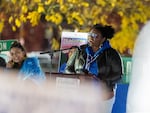This time last year, union educators gathered outside dozens of schools across Portland. Parents walked and drove from nearby neighborhoods. Students were there, too — but rather than going to class, they cheered from the sidelines or chanted and marched with their favorite teachers. A few even passed out Halloween candy to boost morale.
Nov. 1 was the first day of the historic Portland Public Schools teachers strike — the first ever in Oregon’s largest school district. Participants walked the picket lines, signs in hand, as the sun rose behind clouds on the grey fall morning. Thousands of people showed up near schools across the district.
Leaders with the Portland Association of Teachers said they’d reached the point of a strike out of necessity, not choice. Little did they know, the union and district would be stuck at the bargaining table for weeks before reaching an agreement.
The teachers strike lasted nearly the entire month of November, forcing students to make up 11 lost instructional days, with classes replacing half of winter break.

FILE - Teacher Melanie Hindman, center, uses her “teacher voice” as she cheers at a Portland Association of Teachers rally held at Roosevelt High School in Portland, Ore., Nov. 1, 2023. Hindman teaches French at Lincoln High School in Portland.
Kristyna Wentz-Graff / OPB
The duration of the strike created its own problems. Union educators worried their health benefits would be taken away. Questions grew among classified workers responsible for school buildings as they engaged in contract negotiations of their own. Support for teachers generally remained strong among many parents, but the strike took a toll and presented disproportionate challenges for some families.
For weeks, tensions seemed to increase. There were threats and vandalism against key district leaders and board members, allegations from both sides of illegal or unfair labor practices, and inconsistencies between the union and district’s perspectives on what was financially and logistically possible in a new contract.
Gov. Tina Kotek eventually intervened and brought on the state’s chief financial officer, Kate Nass, to get the two sides on the same page regarding finances. Officials from the Oregon Department of Education pored over the district’s budget documents as well.
It took marathon conversations among school board members, top district officials and union leaders to reach a deal on issues ranging from class sizes to compensation. The disconnect in negotiations and delays as other districts also needed state mediators led to bargaining sessions that frequently kept negotiators up around the clock.
By the time students and staff returned to school on Nov. 27, everyone was exhausted.

FILE - Former teacher Erin Savage is tearful after the crowd stood and applauded her testimony before the Portland Public Schools Board of Education, at the PPS district office in Portland, Nov. 7, 2023. Savage taught from 2003-2019 and left the profession for lack of pay, classroom support and frustration.
Kristyna Wentz-Graff / OPB
The district and union signed off on a contract costing $175 million over three years, knowing it would lead to significant budget cuts the following spring. But that cost also allowed for some wins, including cost-of-living increases for teachers, the creation of new committees to govern class sizes, and increased planning time for educators.
In the weeks that followed, it became clear that one of the biggest losses was trust.
“This was a traumatic event for all of us,” PAT President Angela Bonilla said.
Some wounds have begun to heal, with a year of hindsight to learn from. Many changes, including a new PPS superintendent at the helm, have helped wipe the slate clean and instilled hope among many Portland educators.
But some scars still linger, and the impacts of the strike, both positive and negative, have caused ripple effects in bargaining talks in districts across the state.
Celebrating the wins
Though the final contract didn’t reflect all of the union’s top demands, Bonilla can still point to several wins outside of just a bump in salary.
Teachers have more planning time and an additional grading day, for starters, which Bonilla said allows educators to better plan for instruction and provide meaningful feedback to students.
During the strike, teachers would often chant: “Hot, cold, rats, mold. This is getting really old.” Bonilla said classroom educators have seen improvements in the heating, cooling and rodent issues under the new contract.
And perhaps least tangibly — but most importantly — Bonilla has seen more collaboration from the district on a statewide issue: school funding.
“We do not have a quality education system in our state because we’re not funded that way,” she told OPB. “And I think our strike helped really open not just the eyes of our families … but also the public.”

FILE - Staff at Abernethy Elementary School talk to people through a school window, as picketers with the Portland Association of Teachers march outside, Nov. 1, 2023. The Portland Federation of School Professionals (PFSP) and SEIU Local 503 represent a combined 2,000 classified employees in PPS who continue to work through the district’s teacher strike.
Kristyna Wentz-Graff / OPB
PAT represents thousands of educators in the district, which enrolls roughly 44,000 students. As the largest union in the largest school district in the state, the PAT contract has broad significance.
“Folks think about schools as just being an issue that matters to parents and students, but really, it’s an issue that impacts everyone,” Bonilla said. “If we can’t provide a safe and equitable and sustainable education to students, and those same things as working conditions for educators, those are the kids that end up falling through the cracks. Those are the humans that we see on the street. Those are the humans that need more support.
“We are that first touchstone to intervene and provide that support,” she said.
Julia Brim-Edwards is the longest-standing member of the Portland school board and a former parent in the district. She was one of the board members most involved in the negotiations with PAT last fall.
Brim-Edwards, speaking for herself rather than the entire school board or district, said she thinks of the strike as a key opportunity that allowed teachers to put the things that were most important to them on the table.
Ultimately, she said, one win was a sense of alignment with teachers and other staff on some key issues and the shared value that all their decisions center around what students need to be successful.
“Teachers raised some very legitimate issues in the contract negotiations, whether it was receiving adequate and fair compensation … or whether it was advocating for better conditions in our school buildings,” she said. “Those are all issues as a parent and a board member that I value as well.”
Three lessons learned through negotiations
Both Bonilla and Brim-Edwards acknowledged the strike taught them many lessons the hard way.
1) Agree on the numbers
Brim-Edwards’ biggest piece of advice to other districts in bargaining talks is to ensure a common understanding of what financial resources are available. It took days of delayed, frustrating talks where the two sides weren’t on the same page about what the district could actually afford.
“The issue that we had going back and forth is an issue that came up from the Secretary of State’s audit multiple times in a row,” Bonilla said, “which is that there is not transparency in the district’s budget in a way that allows for anyone to go through and say, ‘This is a place where we should cut, and this is a place where we should invest more resources.’
“It is obscure,” she said, “and continues to be obscure.”

FILE - Angela Bonilla, president of the Portland Association of Teachers (PAT) speaks at a rally outside of the Portland Public Schools district office in Portland, Nov. 7, 2023, calling on the district to help bridge the gap at the bargaining table.
Kristyna Wentz-Graff / OPB
Bonilla said the union’s initial data was incorrect because it was reported incorrectly to the Oregon Department of Education by PPS.
“We took the data that PPS themselves reported incorrectly, and then they came around and said, ‘Look … they’re lying to you about all these numbers.’ And we were like, ‘Well, we can’t change them until we get something correct.’
“[ODE] verified that [the district] gave them information they had to reformat,” she continued. “And once we got the new information, we updated those numbers.”
This, Bonilla said, speaks to the need for “both sides” to work together toward a resolution.
“It’s a collective bargaining agreement,” she said. “We should be collectively working towards getting an agreement that serves our students.”
In the end, the total settlement would still put Portland over budget and fall short of giving teachers the compensation increase they wanted.
At the start of the strike, the district offered an approximately 11% cost-of-living adjustment over the three-year agreement. The union wanted more than twice that, coming in at 23%.
Under the contract, educators are receiving a 14.4% compounded increase over the next three years; roughly half of all educators will earn an additional 10.6% from yearly step increases.
Brim-Edwards said districts have to balance what they can actually afford, as responsible stewards of taxpayer dollars, with finding the most equitable compensation package for educators.
“That’s going to be challenging,” she said, “but [keep] in mind that, day to day, teachers are the ones … making the magic happen in the classroom with your students.”
2) Don’t get personal
Brim-Edwards also hopes other communities, no matter how heated the negotiations get, avoid personal targeting of board members as was done in Portland.
She stressed that school board members are volunteers, and often former educators and parents in the district, who care deeply about the schools. Yet, Portland board members were targeted by some at their workplaces and their homes; some district leaders were attacked on social media and had personal property damaged. The union condemned these actions.

FILE - (Left to right) Members of the Portland Public Schools Board of Education Michelle DePass, Herman Greene, Gary Hollands and Julia Brim-Edwards, listen to testimony from a PPS student and parent, both expressing dismay over the proposed calendar for students to make up instruction days missed due to the strike. The testimony was during a special meeting where the board unanimously passed a contract with PAT, at the PPS district offices in Portland, Nov. 28, 2023.
Kristyna Wentz-Graff / OPB
“Nobody wants to see students out of the classroom for an extended period,” Brim-Edwards said. “Boards and districts really want to do everything possible to prevent that from happening. And … oftentimes, even if a board wants to meet all the requests or demands from the other side, we also have to work within the means we have.”
3) Communicate with your constituents
Bonilla said communication was one of the biggest lessons learned. Part of her role in her union leadership is figuring out how to be as democratic, transparent and collaborative as they say they are and want to be. She acknowledged there was a lapse in internal communication with their members, especially in the final few days of the strike, as she was at the bargaining table for hours on end.
“If we had a different structure — you know, had a larger bargaining team and more folks at the table, which previously has not been the way that PPS and PAT had bargained — we would have been able to get those communications out to our members and to our community faster,” she said.
Bonilla encouraged other local associations in contract talks now to think ahead to the final hours of bargaining: “What is the system that you are going to use when you have no brain power, no time and nothing left in the tank?”
Bonilla also stressed the role of school board members. She said negotiations kept getting delayed when the district would say, “Well, we don’t know if the board will do this.”
“Then bring the board,” Bonilla said, playing out the example conversation. “Because we’re literally out of school. We’re on the street. You can’t be delaying things by days. We have to get kids back to school. There wasn’t a sense of urgency from the district.”
Bonilla said school board members there weren’t always helpful, and then-Superintendent Guadalupe Guerrero wasn’t always at the bargaining table. Her advice to other districts is to pay attention to school board races and advocate for people who will prioritize student needs, not be focused on seeking another political office or unwilling to make decisions.
What Oregon districts have already learned from Portland’s example
Earlier this month, the Beaverton School District requested state mediation in contract talks with its teachers' union. And Albany teachers overwhelmingly authorized a potential strike this week as negotiations continue with their district. According to the Oregon Education Association, 49 local unions across the state currently have open contracts.
Some of the same patterns are emerging in these talks as were seen in Portland: disagreements over what’s financially possible, accusations of not bargaining in good faith and assertions that the other side is moving prematurely toward an impasse or strike.
But what’s new is a warning call reverberating throughout the Pacific Northwest — that they don’t want to be the next Portland. Salem-Keizer leaders from both the union and the district repeated similar sentiments this past spring when they narrowly avoided a strike.
Looking forward with a new superintendent and statewide funding push
Several things happened following the return to classes last November, including substantial budget cuts in the spring and the hiring of the new superintendent, Kimberlee Armstrong.
Armstrong has only led Oregon’s largest school district for about four months, starting in July. She said rebuilding trust and relationships within the district and the community is a top priority.
She said she’s hosted and attended listening sessions, consolidated reports to understand the biggest systemic barriers to equity and access in the district, and regularly visited schools to engage directly with students and staff. The district is also starting its budget process earlier this year with the goal of more regularly working with the unions and improving financial transparency.
“These efforts are all focused on fostering a culture of trust and collaboration as we move forward and rise together,” Armstrong said in an emailed statement to OPB.

FILE - Portland Public Schools Superintendent Kimberlee Armstrong visits a Pre-K classroom at Dr. Martin Luther King Jr. Elementary School, June 5, 2024, in Portland, Ore.
Kristyna Wentz-Graff / OPB
Bonilla said working with Armstrong has been “amazing” and “a night-and-day” difference from her relationship with Guerrero. The change alone has given Bonilla and some of even her most skeptical members hope.
“It’s like, when you get out of a bad breakup, and you’re like, ‘I don’t know if I’m ready to love again,’ and then that person comes into your life, and you’re like, ‘Maybe, maybe I can open up my heart a little bit, maybe I can start to trust that you’re not going to harm me, that you’re actually here because you care.’
“Dr. Armstrong is the type of leader that really exudes that,” Bonilla said. “She walks the talk.”
Bonilla and Brim-Edwards both hope the experience in Portland will lead to major financial changes — the top priority of the school board’s recently approved legislative priorities.
PPS had to cut $30 million at the end of last school year, and is expected to face another $40 million deficit this coming spring unless something changes at the state level.
Bonilla hopes the lessons learned from the Portland strike will lead to lasting change — including at the state Capitol.
“We are the canary in the coal mine when it comes to education funding and labor relations in the state,” Bonilla said. “This was the start of a new chapter and a step in a process that is going to inform our legislature, and … the state as a whole, that this is a broken system.
“It cannot, and it will not stand as it is,” she said. “And folks are going to do radical things in order to get change.”
